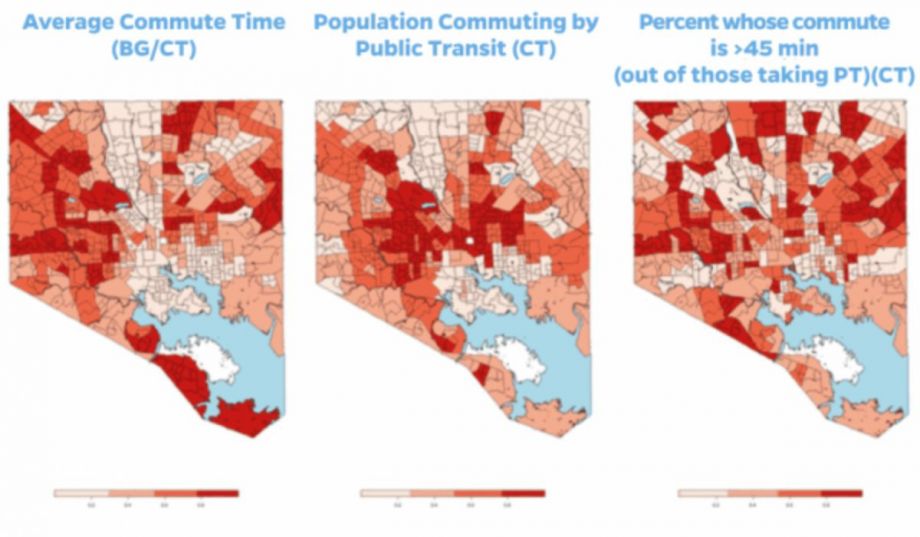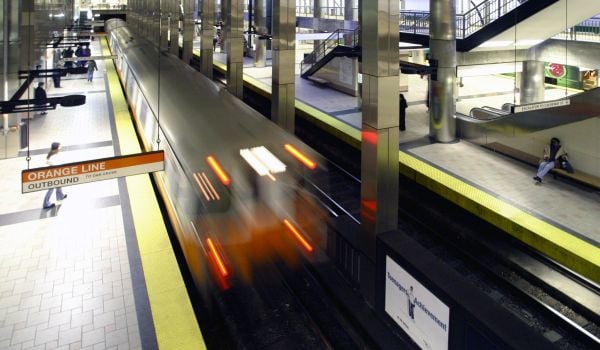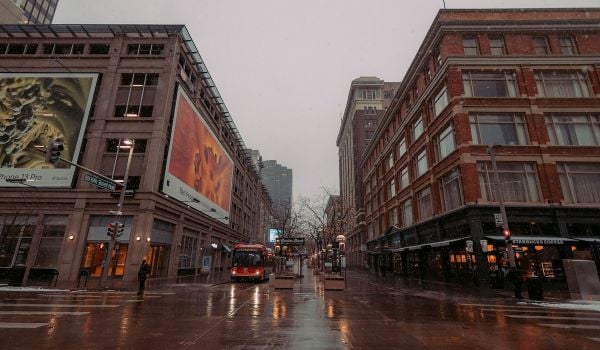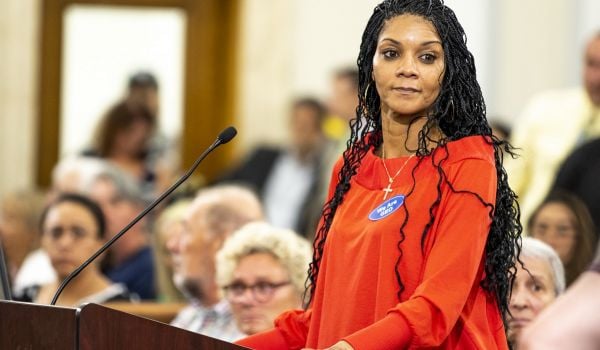Welcome to The Mobile City, our weekly roundup of noteworthy transportation developments.
Study Says Baltimore Transit Has Been Weighed, Measured, and Found Wanting
Segregation in Baltimore takes an interesting form resulting from years of discriminatory housing policies, practices and underinvestment: locals refer to it as “the White L and the Black Butterfly.”
The “White L” is the string of more affluent white neighborhoods that extend north and east from the Inner Harbor, while the “Black Butterfly” refers to the wedges of mostly Black and lower-income neighborhoods that bracket the L on the east and west.
Over the decades, when the state of Maryland has made transportation investments in Baltimore, they have tended to favor the White L as well: The Jones Falls Expressway, the Baltimore Metro heavy-rail subway and the Central Light Rail Line all serve this corridor, while crosstown transit projects that would deliver better transit to heavily nonwhite East and West Baltimore have languished, or worse.
This is one reason why Baltimoreans still seethe at Gov. Larry Hogan’s decision to cancel the east-west Red Line light metro, and that in turn drives Samuel Jordan, founder of the Baltimore Transit Equity Coalition, to continue to fight to make the Red Line a reality.
Jordan points out that the Red Line was fully funded and shovel-ready when Hogan pulled the plug on it. “When Gov. Hogan was elected, he came to office with a $2.95 billion pot of gold on his desk,” he said in an interview for this column. “He didn’t have to lift a finger to raise one penny for [the Red Line].” Nonetheless, Hogan canceled the project, sent a $900 million grant back to the Federal Transit Administration, and redirected the state’s share to road projects in suburban and rural communities, including several Johnson said the communities affected by them did not want.
Then, as a consolation prize of sorts, the Maryland Department of Transportation Maryland Transit Administration (MDOT MTA) unveiled a total revamp of Baltimore’s bus service in 2017. Called Baltimore Link, the revamp promised faster crosstown bus service and easier connections via a system of trunk and feeder routes that mimicked bus rapid transit without the infrastructure improvements.
And to study whether Baltimore Link was an adequate substitute for the Red Line, Jordan managed to enlist the services of one of the White L’s anchor institutions, Johns Hopkins University.
The joint report they produced, “Transit Equity and Environmental Health in Baltimore,” found that Baltimore Link did not produce the transportation improvements East and West Baltimore need, and that the time penalties Black Butterfly residents pay getting to and from work also have health and environmental costs.
The report also lays out a path forward. It uses maps based on Census tract data to show levels of transit access and length of commutes, social vulnerability, incidence of diseases and environmental pollution in the city’s various neighborhoods. The data from three of the four maps — the environmental map was omitted because there are only three air quality monitoring stations in the entire city of Baltimore — are then combined to produce a map showing where the greatest transit investments need to be made.
Megan Weil Latshaw, the associate scientist at Hopkins’ Bloomberg School of Public Health who led the team of researchers that crunched the data and produced the maps, said of the final product, “There were about 46 neighborhoods in six different parts of the city that lit up when we overlaid the four maps as areas of opportunity to [make transit investments].” And with the promise of federal money for transit infrastructure in the Biden administration’s infrastructure bill, she added, “we hope that this is a timely way to strategically drive where the money can go.”
So where should it go? According to the report, it should go to the very neighborhoods in the Black Butterfly that would have been served by the Red Line. Baltimore Link, the report found, did not significantly improve the efficiency of transit service in those neighborhoods; residents there still disproportionately spend 45 minutes or more to reach their jobs, even though they live in the core city, which has the highest level of MDOT MTA service.
But just building the Red Line doesn’t go far enough towards addressing the inequities reinforced by Baltimore transit policy, Jordan said. His group also calls for more transparency from MDOT when it makes transportation spending decisions. And it also calls for more local input into and control over these decisions by replacing the state-run MTA with a Baltimore Regional Transit Authority governed by a locally-chosen board.
“Give us a chance to make the connections that we were making with our study,” Jordan said. “Explore the interconnections among transportation, affordable housing, food security, employment, healthcare, you name it. MDOT MTA has not explored any one of those interconnections in six years.”
New York City Comptroller: Time to Restructure Transit Service Around an All-Day Rush Hour
Mass Transit reports that New York City Comptroller Scott Stringer has issued a report calling on the Metropolitan Transportation Authority to revamp the service it operates in light of the changes in ridership and demand produced by COVID-19.
The report, “Beyond Rush Hour: COVID-19 and the Future of Public Transit,” looked at the way subway and bus ridership changed in each borough during the pandemic and used those changes to produce a series of recommendations for providing transit service to New Yorkers in the post-COVID era.
The report found that public transit usage is now greater among blue-collar than white-collar workers, that 61 percent of service-sector jobs do not follow the traditional 9 a.m.-5 p.m. work schedule. On top of this, today’s transit riders are disproportionately lower-income and live in the outer boroughs.
“The data is clear. The new rush hour is around the clock—and we need to reform our outdated transit system to meet people when and where they are in a post-pandemic economy,” said Stringer. “Frontline workers and New Yorkers in face-to-face jobs can’t afford to wait endlessly at platforms and bus stops for trains and buses that never come. If we want to reduce congestion and encourage people to return to public transit, we need to invest in changes that make public transit an accessible and convenient option for every commuter at every time of day.” The report recommends six-minute intervals throughout the day on subways and high-ridership bus lines, among other changes.
Denver “Walking Artist” Takes to TikTok to Document City’s Awful Sidewalks
For a city associated with active outdoor life, Denver makes it hard for residents to engage in the simplest outdoor activity of all: Walking from place to place.
That’s the message Jonathan Stalls delivers to TikTok users every day, 5280 Magazine reports. Since 2012, the self-described “walking artist” has been leading his fellow Denverites on guided tours of the city’s crumbling and nonexistent sidewalks. But in 2019, while leading a tour through the Ruby Hill neighborhood, a teenage girl approached him to recommend he set up a TikTok account to spread the word more widely.
He dismissed the idea at first — “I can barely figure out Instagram,’’ he told 5280 — but eventually, he acted on it, creating his TikTok account in the summer of 2020. His videos were an instant hit, with his first post receiving 100,000 views.
The videos show such insults as a sidewalk that simply ends and becomes a grassy field and a disintegrating sidewalk alongside a major thoroughfare.
Comments indicate that Stalls has hit a nerve. “This is so isolating and ugly and it’s what so much of America looks like,” one user writes. “You inspired me to go for a walk. I never noticed how bad it was… the sidewalk just stopped,” another user comments.
And the city of Denver has also taken notice. Denver’s Department of Transportation and Infrastructure has said it plans to revamp a program that provides assistance and discounts to private property owners whose sidewalks need repairs and was suspended during the pandemic. It has also launched a program to fill gaps in the sidewalk network using proceeds from a $31 million bond issue meant for sidewalk infrastructure.
Stalls, however, says that all this is just a drop in the bucket. Rattling off a list of Denver thoroughfares whose sidewalks he says need complete reconstruction right now, he told the magazine, “These are streets that people depend on to get to the grocery store. We need more pressure, we need to get louder.”
Smalls encourages Denverites who agree with him to sign up for the Denver Streets Partnership’s “Denver Deserves Sidewalks” campaign.
Know of a development that should be featured in this column? Send a Tweet with links to @MarketStEl using the hashtag #mobilecity.

Next City contributor Sandy Smith is the home and real estate editor at Philadelphia magazine. Over the years, his work has appeared in Hidden City Philadelphia, the Philadelphia Inquirer and other local and regional publications. His interest in cities stretches back to his youth in Kansas City, and his career in journalism and media relations extends back that far as well.
Follow Sandy .(JavaScript must be enabled to view this email address)
















